The Ultimate Guide to Mastering Digital Marketing
Hello and Welcome ;)
This is 0011.digital’s Ultimate Guide to Digital Marketing. With almost two decades of experience in digital marketing, our team has partnered with hundreds of international businesses across various industries to achieve online success—whether through media, SEO, website design, or high-performance ad strategies. We’ve managed millions of dollars in ad spend, crafted hundreds of thousands of ads, and written millions of lines of code and content, refining our approach every step of the way.
In 2024, we set out to create this guide as a living document, capturing the insights we’ve gathered from these years of hands-on experience, alongside powerful industry data. And, as digital marketing evolves, we’re committed to keeping this guide current by updating it as frequently as possible to reflect the latest trends and best practices. Did you know that content marketing generates over three times as many leads per dollar spent compared to traditional advertising, or that 68% of online experiences start with a search engine? As digital marketing becomes increasingly data-driven, 91% of businesses are now leveraging video to connect with audiences, with 86% reporting it boosts lead generation.
This guide is a reflection of our commitment to helping businesses grow by sharing both our successes and hard-earned lessons. We believe that by being open about what’s worked (and what hasn’t), you’ll be better equipped to make data-backed decisions and achieve tangible results. Written with an honest intent to contribute to the public digital knowledge base, this guide represents our core expertise and dedication to the digital marketing community. Let our insights, experience, and dedication serve as your roadmap through the evolving digital landscape, where strategies like mobile optimization and customer-centric marketing—both increasingly expected by today’s consumers—are key to staying ahead.
We love to talk about digital marketing. So, if our approach resonates with you, we’d be thrilled to connect—whether it’s to discuss your business, share insights, or simply chat about the latest in digital marketing. Don’t hesitate to reach out and say hi!
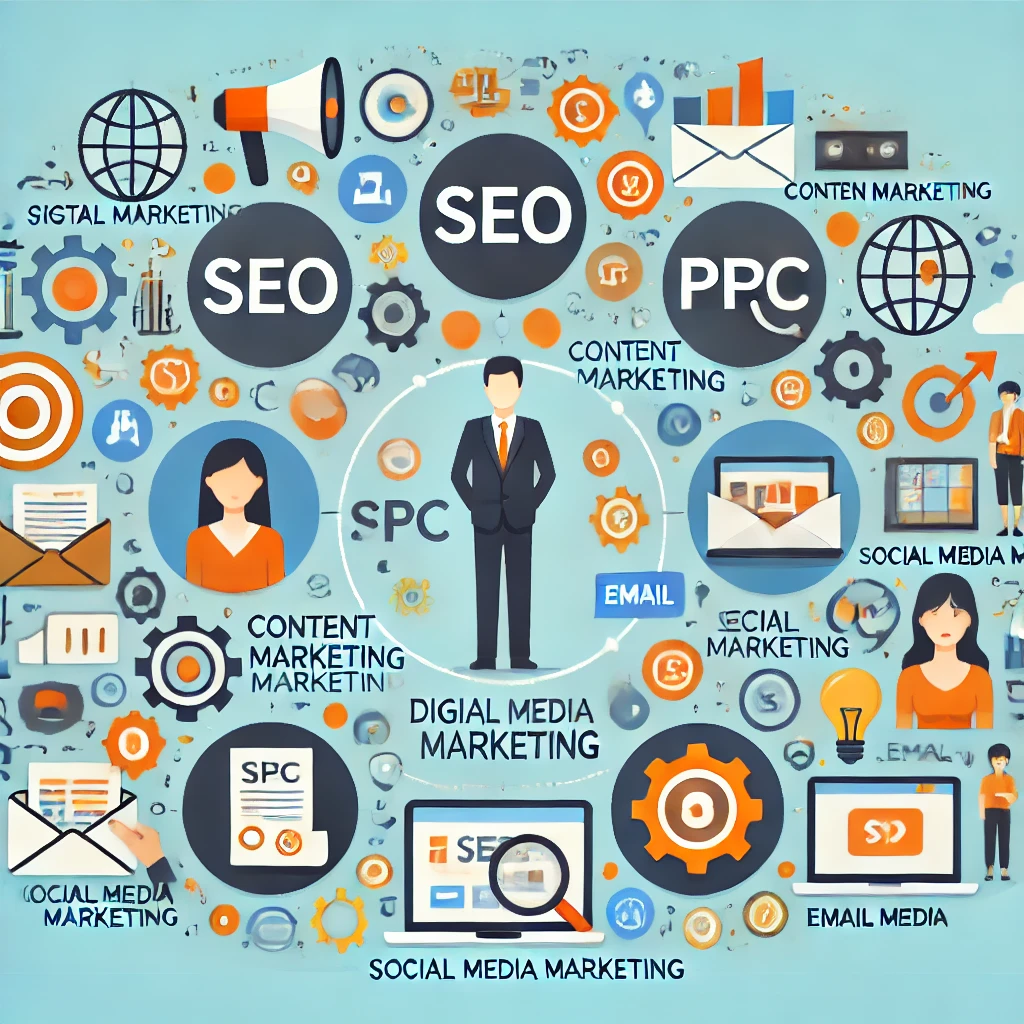
Digital-Marketing-Infographic-that-explains-digital-marketing-with-icons-for-SEO-PPC-content-marketing-social-media-marketing-email-marketing-and-more
What is Digital Marketing?
Digital marketing is the use of digital channels and technologies to promote products and services. Unlike traditional marketing methods, digital marketing leverages online platforms such as websites, social media, email, and search engines to reach and engage with target audiences. This approach allows businesses to connect with potential customers in a more personalized and efficient manner.
When Did Digital Become Traditional?
Digital marketing has revolutionized how businesses connect with audiences, but as digital tactics evolve, a new question arises: at what point does digital marketing become “traditional”?
Established Channels Become Standard: As certain digital channels, like email marketing and social media, become foundational to most marketing strategies, they start to resemble “traditional” methods. For example, email marketing has been a staple for decades, much like TV or radio ads, and is now widely accepted as a standard practice.
Integration with Offline Marketing: Digital marketing also starts to feel traditional when it blends seamlessly with offline tactics. For instance, QR codes on print ads or social media campaigns tied to in-store experiences create a holistic, omnichannel strategy. Here, digital and traditional work together, making the line between them blur.
Ubiquity and User Expectation: When consumers come to expect marketing across digital platforms as part of their daily experience, digital methods begin to feel traditional. Social media marketing, for example, has become so prevalent and universally recognized that it’s almost a given in a brand’s toolkit.
Evolution of New Technologies: As innovative digital technologies like AI-driven personalization, virtual reality, or augmented reality emerge, older digital practices like display advertising or basic SEO may feel more “traditional.” The newest tools often push the previous ones into a more standard, traditional role.
Adoption Across Industries: Lastly, digital practices become traditional as they’re adopted across diverse industries. When every type of business—from local shops to multinational corporations—employs these techniques, they gain a level of “traditional” status due to their widespread use and reliability.
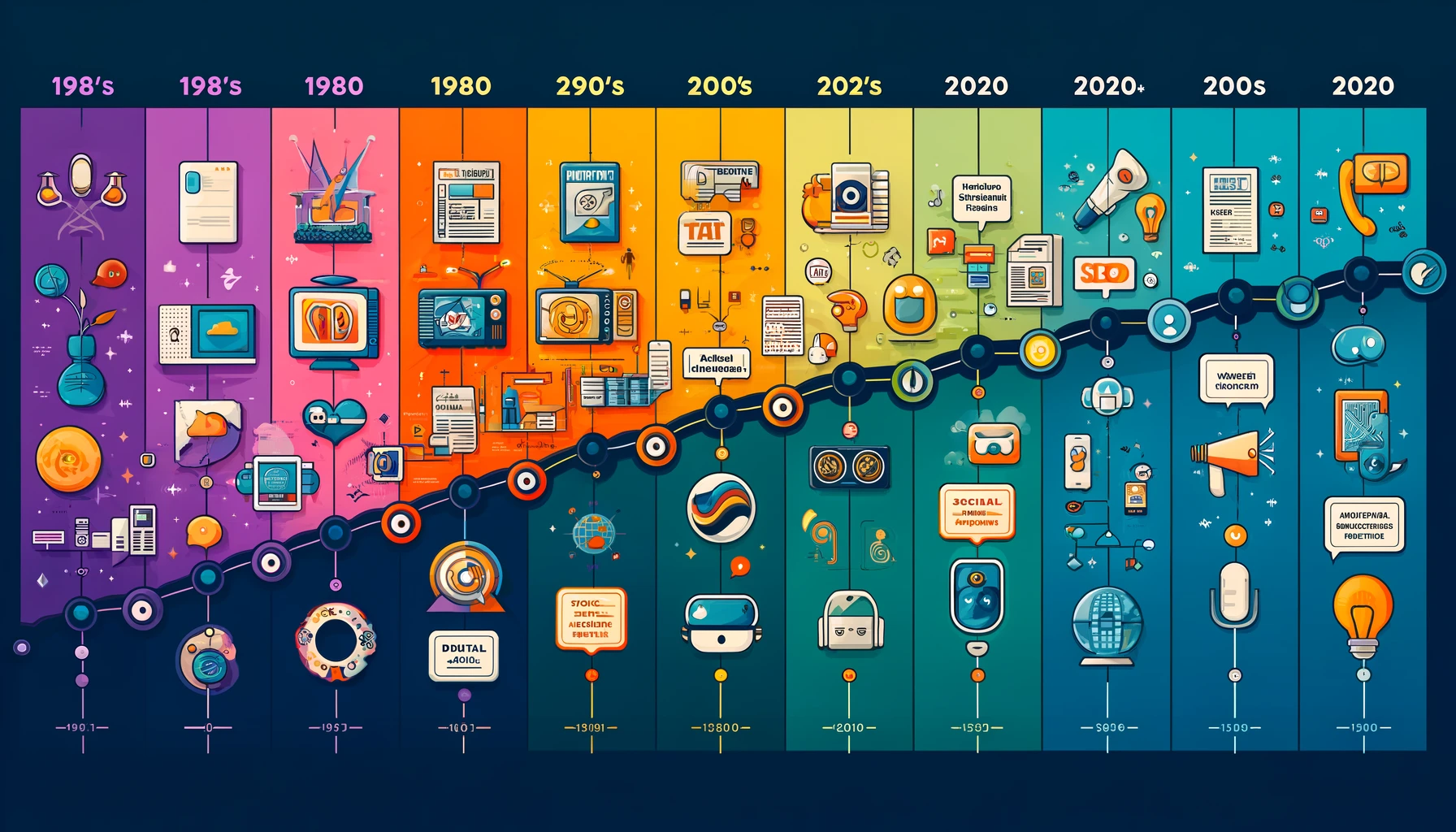
In essence, digital marketing becomes “traditional” when it’s standardized, expected, and part of a broader, integrated strategy that customers recognize and interact with daily. This shift underscores the dynamic nature of digital marketing and its ongoing evolution as new technologies and trends emerge. For us, digital marketing became traditional just before 2020, the 2020 pandemic sealed the deal.
Digital Marketing History
The Birth of the Internet and Digital Marketing Foundations (1980s-1990s)
1980s: As personal computers became more common, the foundation for digital marketing began. Early online systems like CompuServe and AOL allowed companies to experiment with digital communication and early forms of advertising.
1990s: With the advent of the World Wide Web in 1991, digital marketing gained traction. The first clickable banner ad appeared in 1994, marking the birth of what we now know as display advertising. Search engines like Yahoo! (1994) and Google (1998) emerged, setting the stage for search engine optimization (SEO).
The Rise of Search Engines and Email Marketing (Late 1990s-2000s)
Late 1990s: SEO became a critical tool for businesses as they sought to improve visibility on search engines. Email marketing also gained popularity, becoming one of the earliest and most effective digital marketing channels.
2000s: Google introduced AdWords in 2000, bringing pay-per-click (PPC) advertising to the forefront. Meanwhile, SEO strategies evolved alongside algorithm changes, with quality content and keywords playing key roles.
The Social Media Boom (Mid-2000s)
2004-2006: Facebook (2004), YouTube (2005), and Twitter (2006) changed the digital marketing landscape by introducing social media as a key channel for brand engagement. Social media marketing allowed businesses to interact with audiences on a personal level, building community and loyalty.
Late 2000s: Companies quickly integrated social media into their strategies, creating brand profiles and exploring organic and paid social media campaigns. This era marked the beginning of influencer marketing, as brands partnered with popular social media personalities.
Content Marketing and Mobile Optimization (2010s)
Early 2010s: The rise of mobile devices led to the need for mobile-optimized content and websites. Google responded with mobile-friendly algorithm updates, emphasizing the importance of a mobile-first approach.
Content Marketing: Content marketing emerged as a crucial tactic, with brands investing heavily in blogs, videos, and infographics to educate and engage customers. This approach strengthened SEO and brand authority.
Email Automation: Email marketing saw advancements with automation, enabling personalized campaigns based on user behavior and segmentation.
Data-Driven Marketing and Personalization (Late 2010s)
Data-Driven Marketing: With analytics and data insights becoming more sophisticated, brands adopted data-driven strategies to better understand and segment their audience. Real-time analytics allowed marketers to measure campaign performance with precision.
Personalization: Digital marketing became more personalized, with tools enabling marketers to create tailored experiences for individual users. This shift improved customer satisfaction and conversion rates across email, websites, and ads.
Emerging Technologies and the Future of Digital Marketing (2020s)
AI and Machine Learning: Artificial intelligence began powering everything from chatbots to personalized recommendations, making digital marketing more efficient and data-rich.
Voice Search and Smart Devices: As voice-activated devices like Amazon Alexa and Google Assistant became more popular, optimizing for voice search became crucial for digital marketers.
Augmented Reality (AR) and Virtual Reality (VR): AR and VR allowed for immersive brand experiences, especially in sectors like e-commerce and real estate, adding a new dimension to customer engagement.
Importance of Digital Marketing
In today’s digital age, marketing strategies that don’t include digital channels risk falling behind. Digital marketing is crucial because it provides a measurable and cost-effective way to reach a global audience. It enables businesses to engage with their customers in real-time, track campaign performance, and adjust strategies on the fly to optimize results.

Types of Digital Marketing
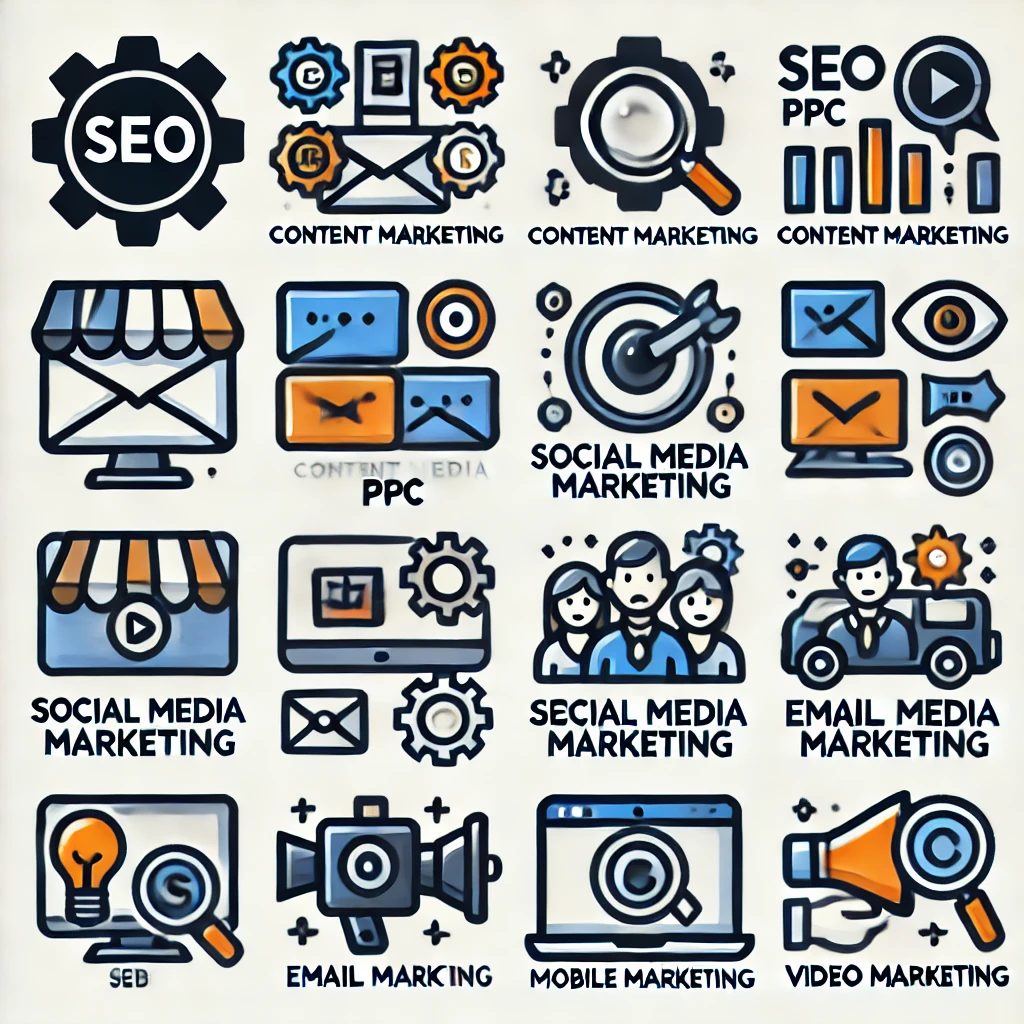
Search Engine Optimization (SEO)
SEO involves optimizing your website to rank higher in search engine results pages (SERPs). This process includes keyword research, on-page SEO (such as improving content quality and meta tags), and off-page SEO (like building backlinks). Effective SEO increases organic traffic and improves the visibility of your website.
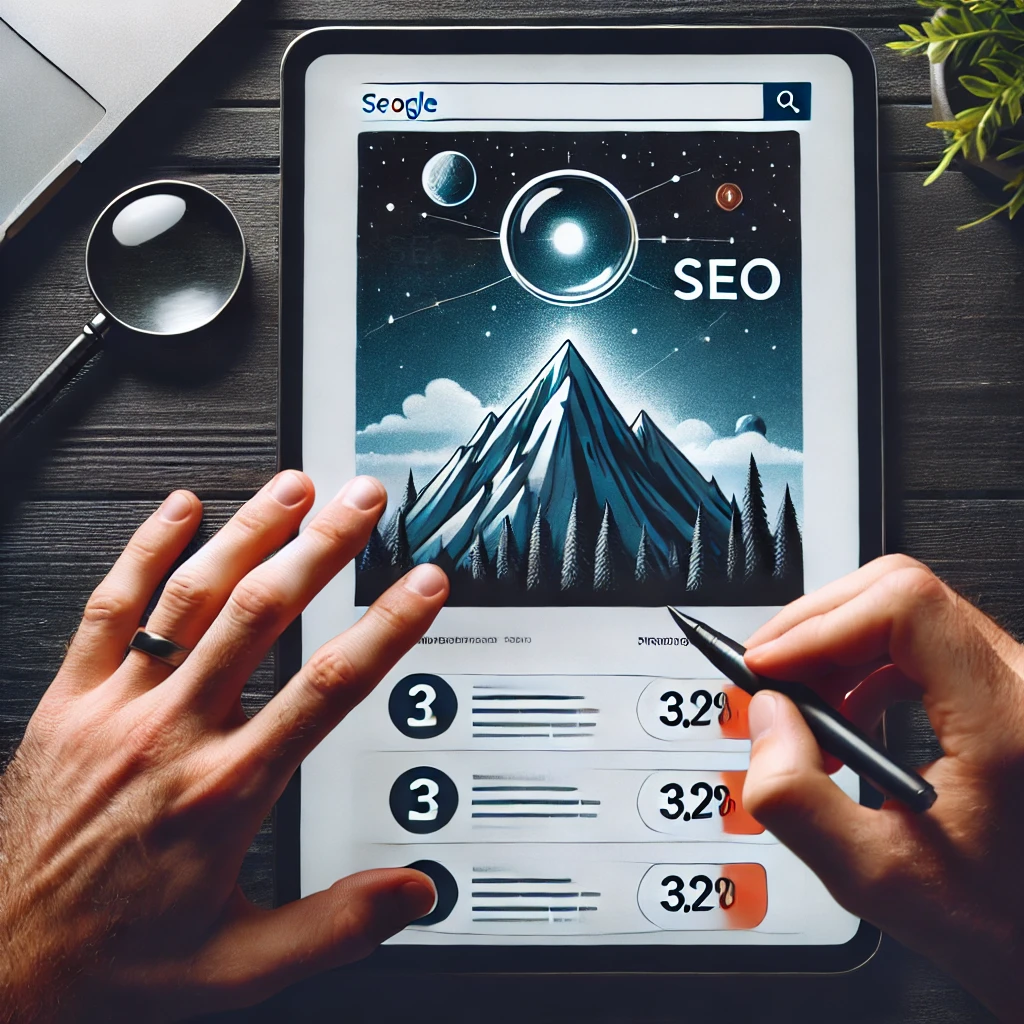
Pay Per Click (PPC)
PPC advertising allows businesses to display ads on search engines and social media platforms, paying a fee each time the ad is clicked. This method can drive targeted traffic quickly and is highly measurable. Google Ads and Facebook Ads are popular platforms for PPC campaigns.
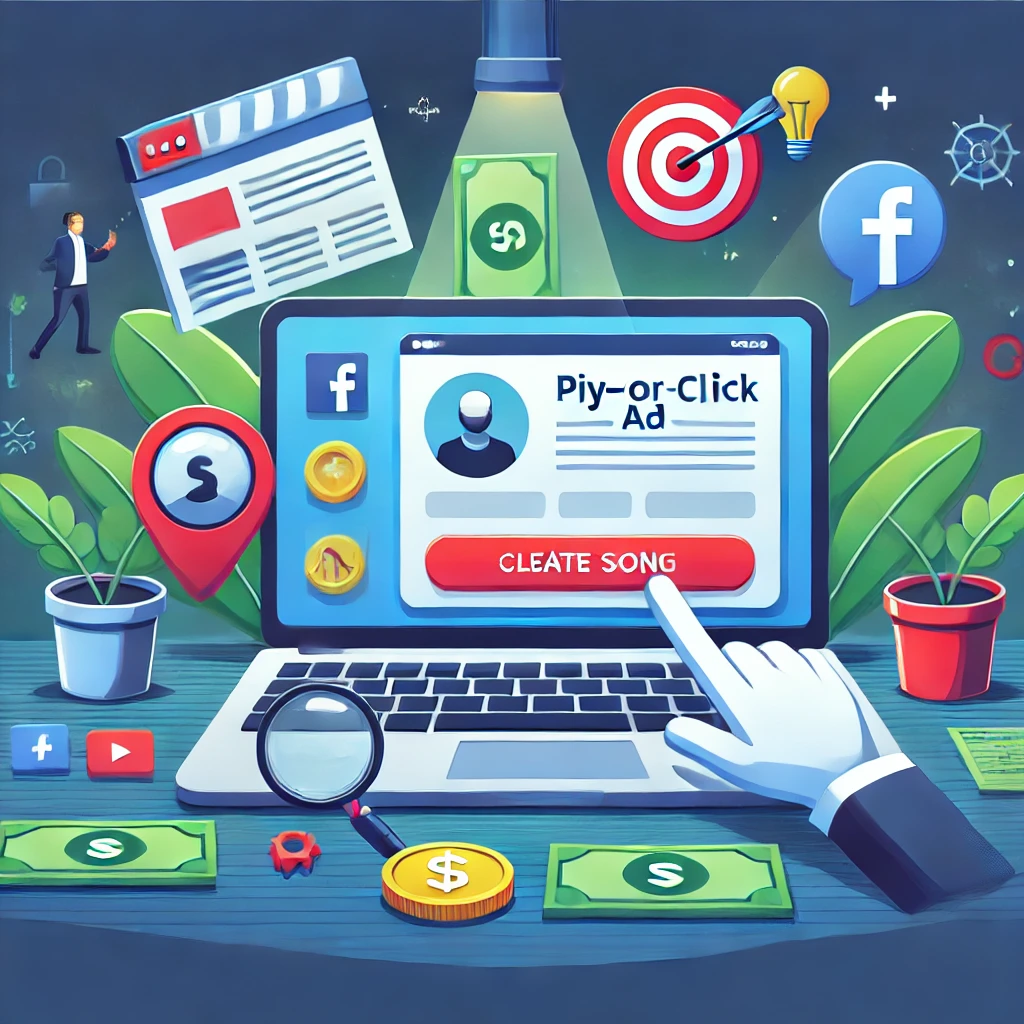
Content Marketing
Content marketing focuses on creating and distributing valuable, relevant content to attract and retain a clearly defined audience. This can include blog posts, articles, videos, infographics, and more. Effective content marketing builds brand authority, improves SEO, and engages potential customers.

Social Media Marketing
Social media marketing uses platforms like Facebook, Twitter, LinkedIn, and Instagram to promote products and services. It involves both organic posts and paid advertising. Social media marketing helps build brand awareness, engage with customers, and drive website traffic.
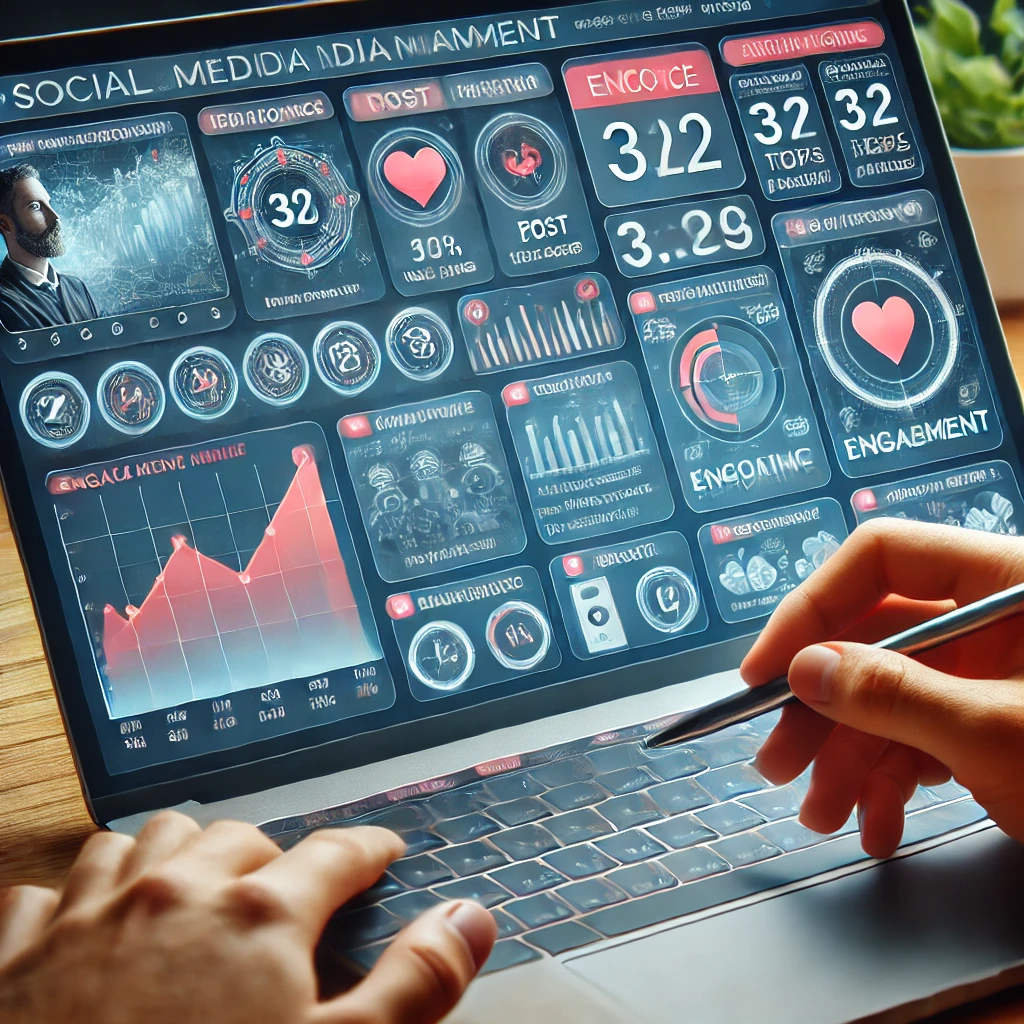
Email Marketing
Email marketing involves sending targeted messages to a list of subscribers to promote products, share news, or provide valuable information. Effective email marketing campaigns can nurture leads, retain customers, and drive sales.
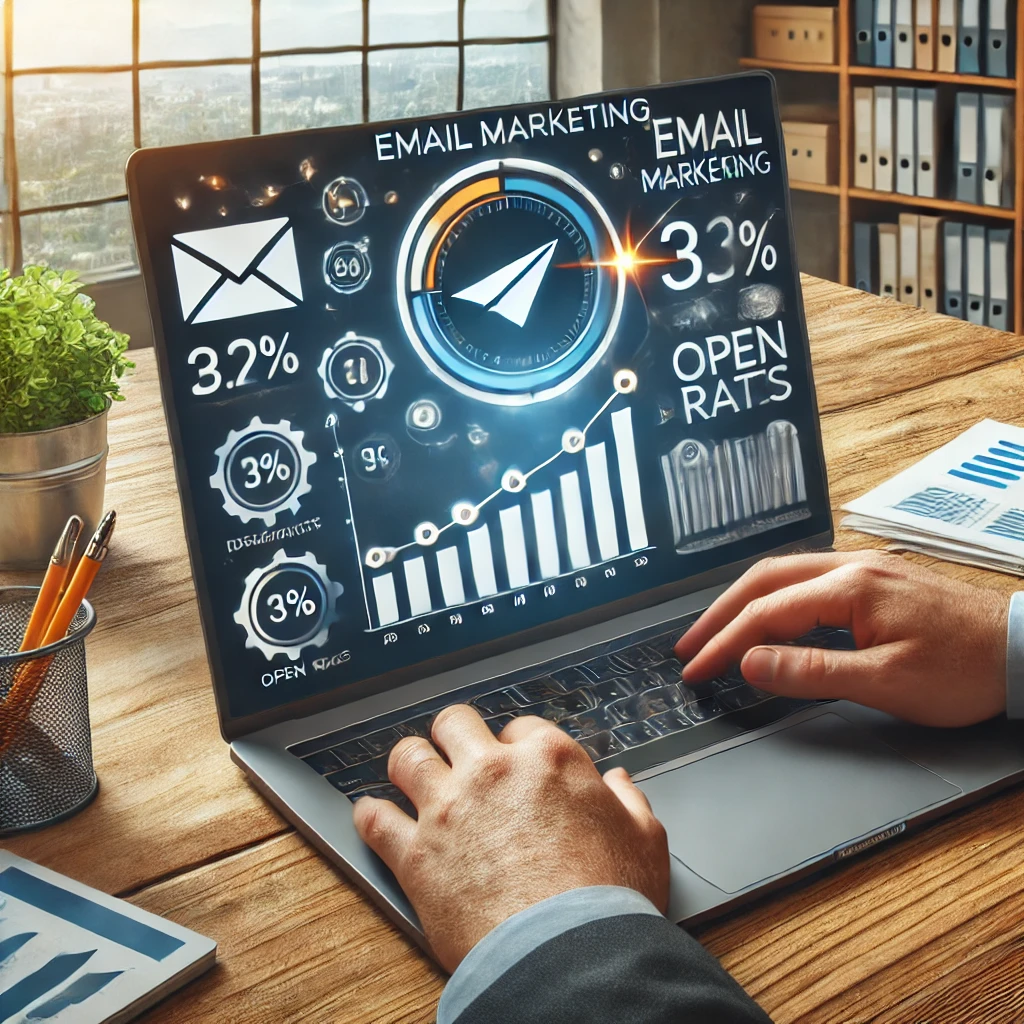
Affiliate Marketing
Affiliate marketing is a performance-based strategy where businesses reward affiliates for driving traffic or sales through their marketing efforts. This involves partners promoting products and earning a commission for each sale or lead generated.
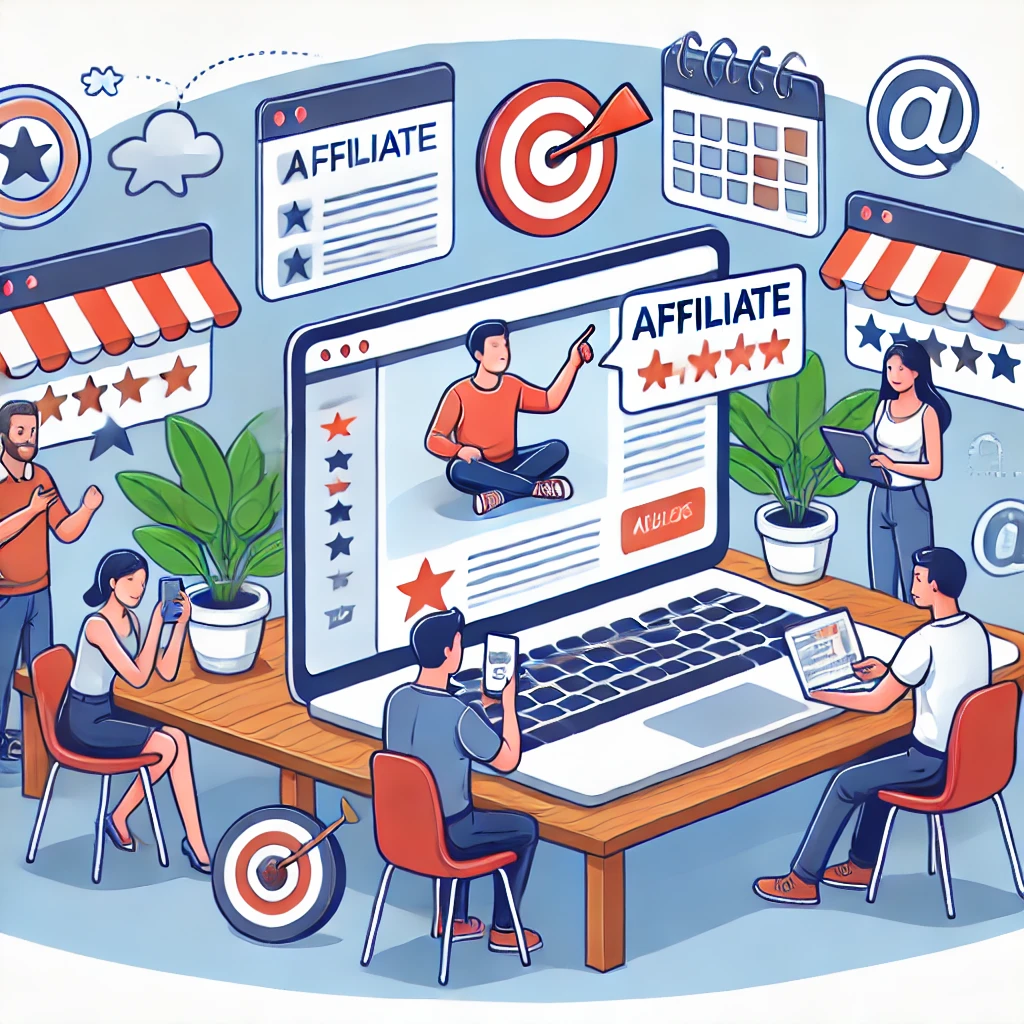
Mobile Marketing
Mobile marketing targets users on mobile devices through SMS, apps, and mobile-optimized websites. This approach ensures that marketing messages reach users wherever they are, providing a seamless and engaging experience.
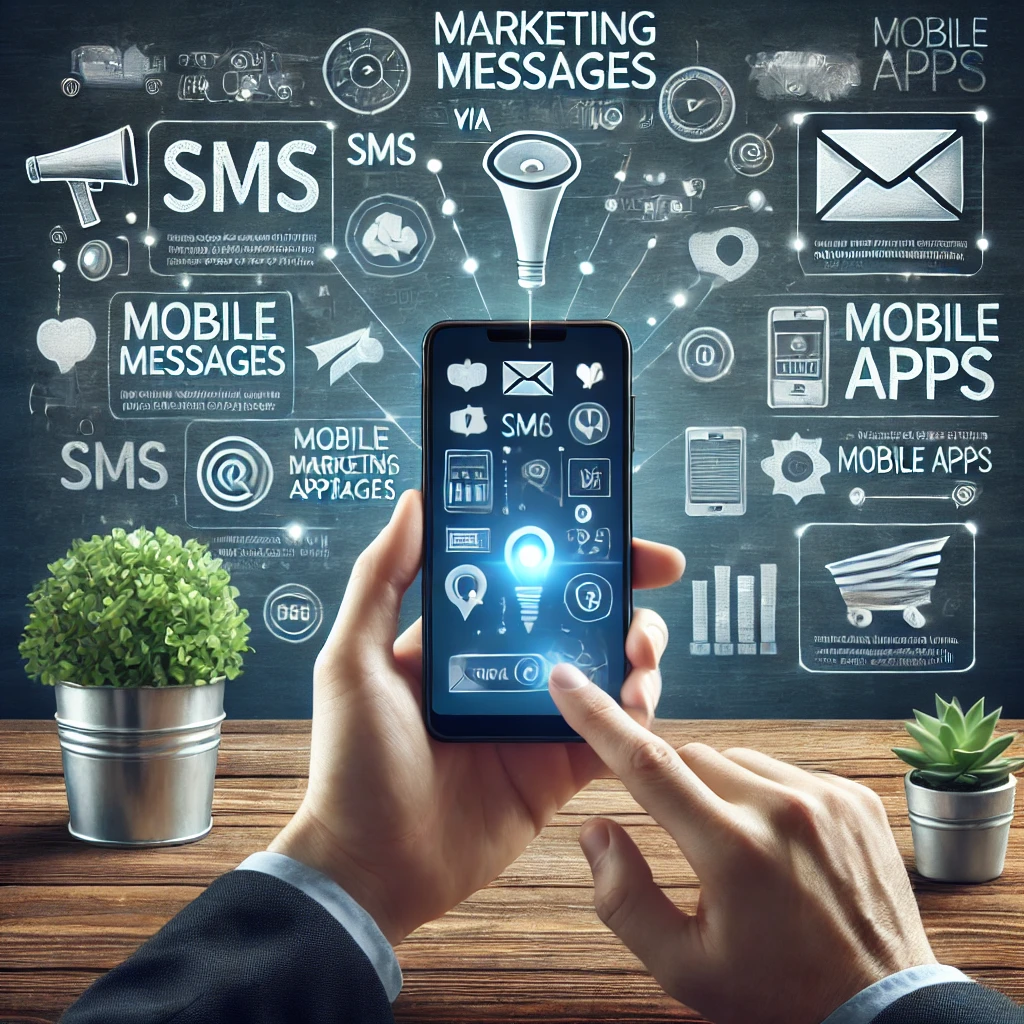
Video Marketing
Video marketing involves creating and sharing videos to promote a brand, product, or service. Platforms like YouTube, TikTok, and Instagram are popular for video marketing. Videos can increase engagement, improve SEO, and drive conversions.
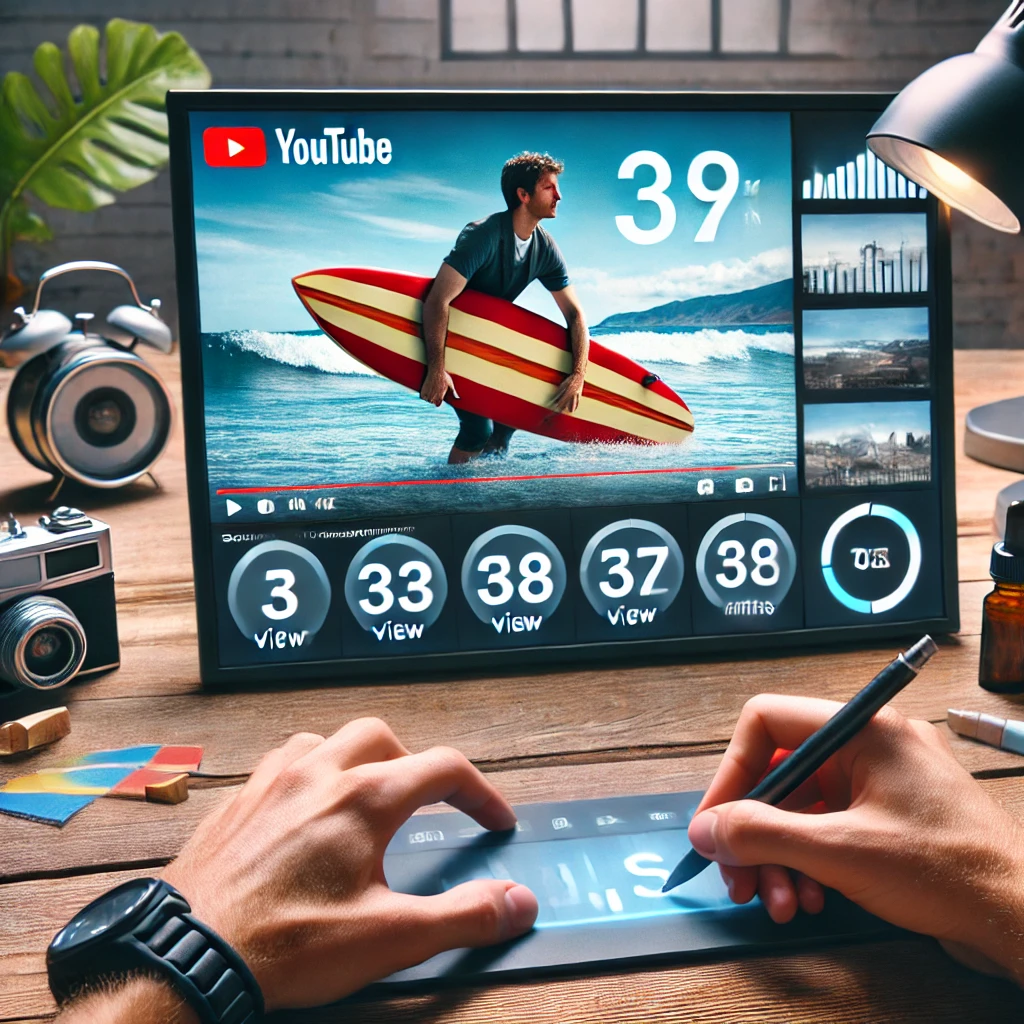
Core Digital Marketing Strategies
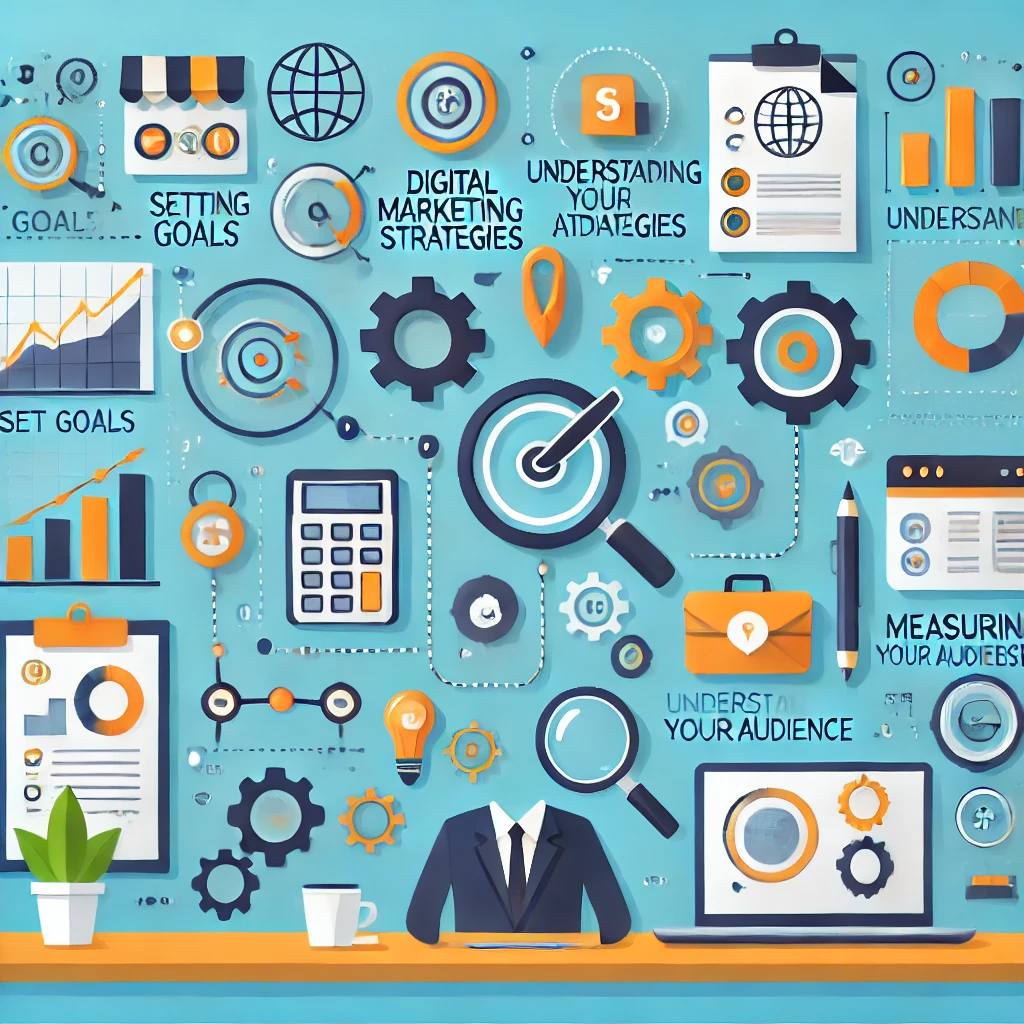
Setting Goals
Setting clear and measurable goals is the foundation of any successful digital marketing strategy. Goals should align with business objectives and be specific, measurable, achievable, relevant, and time-bound (SMART).
Understanding Your Audience
Knowing your audience is crucial for crafting effective marketing messages. This involves creating buyer personas, understanding customer pain points, and identifying the channels they use most frequently.
Creating a Marketing Plan
A comprehensive marketing plan outlines the strategies and tactics needed to achieve your goals. This includes defining your target audience, selecting the right channels, and planning content and campaigns.
Leveraging Tools and Technologies
Utilizing digital marketing tools can enhance your strategy. Tools like Google Analytics, HubSpot, and SEMrush provide valuable insights and automation capabilities that streamline marketing efforts.
Measuring and Analyzing Results
Measuring the performance of your campaigns is essential for understanding what works and what doesn’t. Key Performance Indicators (KPIs) such as conversion rates, click-through rates, and return on investment (ROI) help evaluate success.
Benefits of Digital Marketing
Cost-Effectiveness
Digital marketing is often more affordable than traditional marketing methods. With precise targeting and real-time analytics, businesses can optimize their budgets and achieve better ROI.
Measurable Results
Digital marketing provides detailed analytics and performance data, allowing businesses to track the success of their campaigns and make data-driven decisions.
Customer Engagement
Digital marketing facilitates direct interaction with customers through social media, email, and online communities. This engagement helps build stronger relationships and brand loyalty.
Flexibility and Adaptability
Digital marketing campaigns can be quickly adjusted based on real-time data, allowing for agile responses to market changes and emerging trends.
Tools and Technologies
Essential Tools
Essential digital marketing tools include Google Analytics for tracking website performance, HubSpot for marketing automation, and SEMrush for SEO and competitive analysis.
Analytics Platforms
Analytics platforms like Google Analytics and Adobe Analytics provide insights into user behavior, helping businesses understand how visitors interact with their website and marketing campaigns.
Marketing Automation
Marketing automation tools like HubSpot and Mailchimp streamline repetitive tasks, such as email campaigns and social media posting, allowing marketers to focus on strategy and creativity.
Practical Tips for Implementation
Setting Up Your Campaigns
Effective campaign setup involves defining your goals, selecting the right platforms, and crafting compelling messages. It’s important to test different elements to see what resonates best with your audience.
Budgeting and Resource Allocation
Allocate your budget based on the expected ROI of each channel. Focus on high-performing channels but remain flexible to shift resources as needed.
Content Creation Best Practices
Create high-quality, relevant content that addresses your audience’s needs and pain points. Use a mix of formats, such as blog posts, videos, and infographics, to keep your audience engaged.
Social Media Engagement Tactics
Engage with your audience on social media by responding to comments, participating in conversations, and sharing valuable content. Use paid social media campaigns to amplify your reach.
Measuring Success
Key Performance Indicators (KPIs)
KPIs help measure the success of your digital marketing efforts. Common KPIs include website traffic, conversion rates, click-through rates, and social media engagement.
Analyzing Data
Regularly analyze your data to understand what’s working and what isn’t. Use these insights to refine your strategies and improve performance.
Optimizing Campaigns
Continuously optimize your campaigns based on performance data. Test different elements, such as headlines and calls-to-action, to see what drives the best results.
Case Studies and Real-Life Examples
Coming Soon.
Industry-Specific Strategies
E-commerce
For e-commerce businesses, focus on driving traffic to your website, optimizing the user experience, and increasing conversion rates. Use SEO, PPC, and social media marketing to attract and engage customers.
B2B vs B2C
B2B and B2C marketing strategies differ significantly. B2B strategies often involve longer sales cycles and more personalized approaches, while B2C strategies focus on emotional appeal and quick conversions.
Regional Considerations
Consider regional differences in your marketing strategies. Tailor your approach to suit cultural preferences, language, and local trends.
Emerging Trends in Digital Marketing
AI and Machine Learning
Artificial intelligence and machine learning are transforming digital marketing. These technologies enable more personalized marketing, predictive analytics, and automation of repetitive tasks.
Voice Search Optimization
With the rise of voice-activated devices, optimizing for voice search is becoming increasingly important. Focus on natural language keywords and provide concise, informative answers to common questions.
Augmented Reality and Virtual Reality
AR and VR are creating new opportunities for immersive marketing experiences. Use these technologies to engage customers in innovative ways, such as virtual try-ons or interactive product demos.
Personalization and Customer Experience
Personalization is key to delivering a superior customer experience. Use data to tailor your marketing messages and create personalized journeys for your customers.
Conclusion
Digital marketing offers a dynamic and effective way to reach and engage with your target audience. By leveraging various digital channels and staying updated with emerging trends, businesses can achieve their marketing goals and drive growth.



